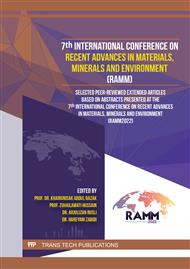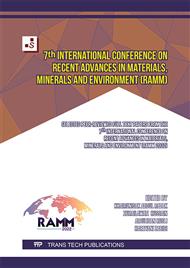[1]
ASTM C642-13, 2013. Standard Test Method for Density, Absorption, and Voids in Hardened Concrete, ASTM International, West Conshohocken, PA. www.astm.org
Google Scholar
[2]
ASTM C1585-20, Standard Test Method for Measurement of Rate of Absorption of Water by Hydraulic-Cement Concretes, ASTM International, West Conshohocken, PA, 2020, www.astm.org
Google Scholar
[3]
ASTM C150 / C150M-20, Standard Specification for Portland Cement, ASTM International, West Conshohocken, PA, 2020, www.astm.org
Google Scholar
[4]
ASTM C136 / C136M-19, Standard Test Method for Sieve Analysis of Fine and Coarse Aggregates, ASTM International, West Conshohocken, PA, 2019, www.astm.org
Google Scholar
[5]
ASTM C1240-20, Standard Specification for Silica Fume Used in Cementitious Mixtures, ASTM International, West Conshohocken, PA, 2020, www.astm.org
Google Scholar
[6]
Adnan, S. H., Abadalla, M. A., & Jamellodin, Z. (2017). The mechanical and physical properties of concrete containing polystyrene beads as aggregate and palm oil fuel ash as cement replacement material
DOI: 10.1063/1.5005349
Google Scholar
[7]
Al-Menyawi, Y. M. (2001). Concrete block masonry construction to resist severe winds.
Google Scholar
[8]
Almesfer, N., & Ingham, J. (2014, 02). Effect of waste latex paint on concrete. Cement and Concrete Composites, 46, 19-25
DOI: 10.1016/j.cemconcomp.2013.10.017
Google Scholar
[9]
Askari, A., Sohrabi, M. R., & Rahmani, Y. (2011, 05). An Investigation into Mechanical Properties of Self Compacting Concrete Incorporating Fly Ash and Silica Fume at Different Ages of Curing. Advanced Materials Research, 261-263, 3-7. https://doi.org/10.4028/ www.scientific.net/amr.261-263.3
DOI: 10.4028/www.scientific.net/amr.261-263.3
Google Scholar
[10]
Asutkar, P., Shinde, S., & Patel, R. (2017, 02). Study on the behaviour of rubber aggregates concrete beams using analytical approach. Engineering Science and Technology, an International Journal, 20(1), 151-159
DOI: 10.1016/j.jestch.2016.07.007
Google Scholar
[11]
Babu, K. G., & Prakash, P. S. (1995, 08). Efficiency of silica fume in concrete. Cement and Concrete Research, 25(6), 1273-1283
DOI: 10.1016/0008-8846(95)00120-2
Google Scholar
[12]
BS-2028 (1975). Precast Concrete Block, British Standard Institution, London, UK.
Google Scholar
[13]
Chung, S., Elrahman, M. A., & Stephan, D. (2018, 04). Effects of expanded polystyrene (EPS) sizes and arrangements on the properties of lightweight concrete. Materials and Structures, 51(3)
DOI: 10.1617/s11527-018-1182-3
Google Scholar
[14]
Drysadale, R.G., Hamid, A.A., and Baker, L.R. (1994). Masonry Structures: Behaviour and Design, Prentice-Hall, Eaglewood Cliffs, N.J.
Google Scholar
[15]
Fardis, M. N. (2017). Seismic design of concrete buildings to Eurocode 8. Boca Raton, FL: CRC Press.
Google Scholar
[16]
Ganjian, E., Khorami, M., & Maghsoudi, A. A. (2009, 05). Scrap-tyre-rubber replacement for aggregate and filler in concrete. Construction and Building Materials, 23(5), 1828-1836
DOI: 10.1016/j.conbuildmat.2008.09.020
Google Scholar
[17]
Gnip, I., Vaitkus, S., Keršulis, V., & Vėjelis, S. (2011, 08). Analytical description of the creep of expanded polystyrene (EPS) under long-term compressive loading. Polymer Testing, 30(5), 493-500
DOI: 10.1016/j.polymertesting.2011.03.012
Google Scholar
[18]
Ham, R. B. (2008). Residential construction academy: Masonry: Brick and block construction. Clifton Park, NY: Thomson Delmar Learning.
Google Scholar
[19]
Herki, B., & Khatib, J. (2016, 04). Valorisation of waste expanded polystyrene in concrete using a novel recycling technique. European Journal of Environmental and Civil Engineering, 21(11), 1384-1402
DOI: 10.1080/19648189.2016.1170729
Google Scholar
[20]
Holmes, N., O'malley, H., Cribbin, P., Mullen, H., & Keane, G. (2016, 07). Performance of masonry blocks containing different proportions of incinator bottom ash. Sustainable Materials and Technologies, 8, 14-19
DOI: 10.1016/j.susmat.2016.05.001
Google Scholar
[21]
Jusli, E., Nor, H. M., Jaya, R. P., Haron, Z., & Azman, M. (2014, 12). Effect of Using Waste Tyre Rubber on the Properties of Double Layer Rubberized Concrete Paving Blocks. Jurnal Teknologi, 71(3)
DOI: 10.11113/jt.v71.3750
Google Scholar
[22]
Kaushik, H. B., Rai, D. C., & Jain, S. K. (2007, 09). Stress-Strain Characteristics of Clay Brick Masonry under Uniaxial Compression. Journal of Materials in Civil Engineering, 19(9), 728-739
DOI: 10.1061/(asce)0899-1561(2007)19:9(728)
Google Scholar
[23]
Khamput, P. (2006). A-23 USING LATEX FROM PARA-RUBBER FOR DEVELOPING STRENGTH AND THERMAL INSULATION PROPERTIES OF CONCRETE BLOCK(Session: Inorganic Materials). The Proceedings of the Asian Symposium on Materials and Processing, 2006(0), 23
DOI: 10.1299/jsmeasmp.2006.23
Google Scholar
[24]
Li, X., & Chung, D. (1998, 04). Improving Silica Fume for Concrete by Surface Treatment 11Communicated by D.M. Roy. Cement and Concrete Research, 28(4), 493-498
DOI: 10.1016/s0008-8846(98)00017-9
Google Scholar
[25]
Mampearachchi, W. (2019). Good Practices in Concrete Block Laying. Handbook on Concrete Block Paving, 51-57
DOI: 10.1007/978-981-13-8417-2_5
Google Scholar
[26]
Mohammed, B. S., Hossain, K. M., Swee, J. T., Wong, G., & Abdullahi, M. (2012, 03). Properties of crumb rubber hollow concrete block. Journal of Cleaner Production, 23(1), 57-67
DOI: 10.1016/j.jclepro.2011.10.035
Google Scholar
[27]
MS 7.6:1972, (2010). Malaysian Standard, Department of Standard Malaysia 2010. General specification of bricks.
Google Scholar
[28]
Nguyen-Ngoc, H., Dang, B., Nguyen-Xuan, H., Thao, H. D., & Wahab, M. A. (2018, 08). Three-Dimensional Analysis of an Innovative Hollow Concrete Block of Interlocking Revetment. Proceedings of the 1st International Conference on Numerical Modelling in Engineering Lecture Notes in Civil Engineering, 112-122
DOI: 10.1007/978-981-13-2405-5_9
Google Scholar
[29]
Phillips, M. L. (2001, 07). What is "powder free"? Characterisation of powder aerosol produced during simulated use of powdered and powder free latex gloves. Occupational and Environmental Medicine, 58(7), 479-481
DOI: 10.1136/oem.58.7.479
Google Scholar
[30]
Rivas-Vázquez, L. P., Suárez-Orduña, R., Hernández-Torres, J., & Aquino-Bolaños, E. (2014, 06). Effect of the surface treatment of recycled rubber on the mechanical strength of composite concrete/rubber. Materials and Structures, 48(9), 2809-2814
DOI: 10.1617/s11527-014-0355-y
Google Scholar
[31]
Sajedi, F., & Shafigh, P. (2012, 04). High-Strength Lightweight Concrete Using Leca, Silica Fume, and Limestone. Arabian Journal for Science and Engineering, 37(7), 1885-1893
DOI: 10.1007/s13369-012-0285-3
Google Scholar
[32]
Siddique, R., & Naik, T. R. (2004, 01). Properties of concrete containing scrap-tire rubber – an overview. Waste Management, 24(6), 563-569
DOI: 10.1016/j.wasman.2004.01.006
Google Scholar
[33]
Siddique, R. (2011, 09). Utilization of silica fume in concrete: Review of hardened properties. Resources, Conservation and Recycling, 55(11), 923-932. https://doi.org/
DOI: 10.1016/j.resconrec.2011.06.012
Google Scholar
[34]
Sneck, T., (1978). 'Dependence of masonry properties on the interaction between masonry units and mortar', Proceedings of North American Masonry Conference, Noland, J. L. and Amrhein, J. E., Ed., (Colorado, USA) 21.1–21.12.
Google Scholar
[35]
Wani, M. V., & Kumar, M. C. (2018, 06). Behaviour of Interlocking Hollow Concrete Blocks. International Journal of Trend in Scientific Research and Development, Volume-2(Issue-4), 2850-2882
DOI: 10.31142/ijtsrd14173
Google Scholar
[36]
Wei, H., Liu, Y., Wu, T., & Liu, X. (2020, 03). Effect of Aggregate Size on Strength Characteristics of High Strength Lightweight Concrete. Materials, 13(6), 1314
DOI: 10.3390/ma13061314
Google Scholar
[37]
West, N.W.H. (1974). A Note on the Suction Rate Test for Bricks. In: Proceeding of the Conference of the British Ceramic Society, November 1974. pp.21-31.
Google Scholar
[38]
Wong, H., & Razak, H. A. (2005, 04). Efficiency of calcined kaolin and silica fume as cement replacement material for strength performance. Cement and Concrete Research, 35(4), 696-702
DOI: 10.1016/j.cemconres.2004.05.051
Google Scholar



